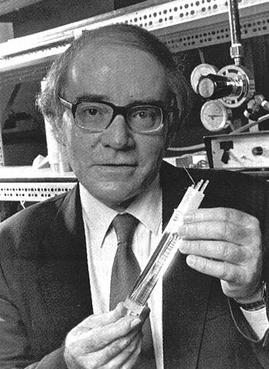
Cold fusion is a hypothesized type of nuclear reaction that would occur at, or near, room temperature. It would contrast starkly with the "hot" fusion that is known to take place naturally within stars and artificially in hydrogen bombs and prototype fusion reactors under immense pressure and at temperatures of millions of degrees, and be distinguished from muon-catalyzed fusion. There is currently no accepted theoretical model that would allow cold fusion to occur.
Pathological science is an area of research where "people are tricked into false results ... by subjective effects, wishful thinking or threshold interactions." The term was first used by Irving Langmuir, Nobel Prize-winning chemist, during a 1953 colloquium at the Knolls Research Laboratory. Langmuir said a pathological science is an area of research that simply will not "go away"—long after it was given up on as "false" by the majority of scientists in the field. He called pathological science "the science of things that aren't so."
Malcolm Arthur McKinnon is a New Zealand historian and political historian. McKinnon's work largely focuses on the history of New Zealand and New Zealand's international relations. McKinnon has held a number of editorial roles, including at New Zealand International Review and as theme editor of Te Ara: The Encyclopedia of New Zealand.
Martin Gerhardt Banwell, Hon.FRSNZ is an organic chemist specialising in biotransformations and natural product synthesis.
Lydia Joyce Wevers was a New Zealand literary historian, literary critic, editor, and book reviewer. She was an academic at Victoria University of Wellington for many years, including acting as director of the Stout Research Centre for New Zealand Studies from 2001 to 2017. Her academic research focussed on New Zealand literature and print culture, as well as Australian literature. She wrote three books, Country of Writing: Travel Writing About New Zealand 1809–1900 (2002), On Reading (2004) and Reading on the Farm: Victorian Fiction and the Colonial World (2010), and edited a number of anthologies.
Memons in South Africa form a prosperous Muslim subgroup in that country's Indian community and are largely descended from Memons from Kathiawar who immigrated from India in the late 19th century/early 20th century. Villages and towns that South African Memons originated from include Porbander, Bhanvad, Ranavav and Jodiya.

Martin Fleischmann FRS was a British chemist who worked in electrochemistry. Premature announcement of his cold fusion research with Stanley Pons, regarding excess heat in heavy water, caused a media sensation and elicited skepticism and criticism from many in the scientific community.
Michael O'Leary is a New Zealand publisher, poet, novelist, performer, and bookshop proprietor. He publishes under the imprint Earl of Seacliff Art Workshop, which he founded in 1984. He runs a bookshop with Irving Lipshaw, Kakariki Books, from the Paekakariki railway station.
Andrea Rossi is an Italian entrepreneur who claimed to have invented a cold fusion device.
Bruce Gordon McFadgen is a New Zealand surveyor and archaeologist.

John Robert Huizenga was an American physicist who helped build the first atomic bomb and who also debunked University of Utah scientists' claim of achieving cold fusion.
Arapata Tamati Hakiwai is a New Zealand museum curator of Māori collections. He is a principal investigator with Ngā Pae o te Māramatanga, a Māori research centre at University of Auckland.
Richard Irving Walcott is a New Zealand geologist known for his work on plate tectonics.
Lisa Marriott is a New Zealand accounting academic. She is currently a full professor at Victoria University of Wellington.
Wilfred Gordon Malcolm was a New Zealand mathematician and university administrator. He was professor of pure mathematics at Victoria University of Wellington from the mid 1970s, until serving as vice-chancellor of the University of Waikato between 1985 and 1994.
Diane Seward is a low temperature thermochronologist. She is currently a Teaching Fellow at Victoria University of Wellington and affiliated with GNS Science. Seward's work has predominantly focused on thermochronology applied to basin analysis and tectonic evolution. Her research has also been instrumental in developing dating of volcanic deposit through fission track analysis.

Rachel Margaret Esson is the National Librarian Te Pouhuaki of New Zealand. Before moving into that role in 2020, she served in several positions at the Victoria University of Wellington library and the National Library of New Zealand, including Director of Content Services. Esson also served as the president of LIANZA, New Zealand's national library association, from 2019 to 2020.
Michalia Arathimos is a Greek–New Zealand writer. She has held several writers' residencies in New Zealand, and received several awards for her short stories. Her debut novel, Aukati, was published in 2017.
Lara Strongman is a curator, writer and art historian from New Zealand.
Jessica Christine Lai is a New Zealand academic, and is a full professor at Victoria University of Wellington, specialising in the interaction of intellectual property rights and indigenous knowledge.




